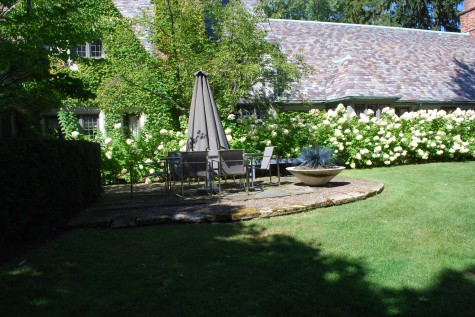
Some time ago I wrote about a client who told me that no matter how beautiful his house might be on the inside, in the end, it is his cave. I am quite sure he chose the word cave, as he feels his winter is tantamount to a forced hibernation. Garden people have strong feelings like this-me included. I do make an effort to live through the winter, as best I can; more to follow on that. The upshot-I move to a diferent kind of making- as in small sculptures from natural materials. Some of these bits are left over from other projects. The shells in this topiary were left from my shell tower construction. The trunk sticks came from a spring centerpiece I no longer needed, but couldn’t quite throw away. Some materials I buy specifically for interior arrangements for the home. I buy little pots all year long for these projects. Who doesn’t have a small space somewhere that could be enlivened by a little dose of nature? A little dose of nature- hand conceived and built-this helps brighten my winter.
 Eucalyptus is not native or hardy in Michigan, but its sturdy broad leaves remind me of boxwood- super sized, that is. Eucaylptus takes well to being preserved; the lush and lively look pictured above will last a very long time. The delicate cedar whip stems are arranged around a stout stick under a rubber band, and then glued. The trunk has interesting texture, does it not? Preserved reindeer moss covers the top of the clay pot. The moss is set low enough such that the terra cotta pie crust edge can still be seen.
Eucalyptus is not native or hardy in Michigan, but its sturdy broad leaves remind me of boxwood- super sized, that is. Eucaylptus takes well to being preserved; the lush and lively look pictured above will last a very long time. The delicate cedar whip stems are arranged around a stout stick under a rubber band, and then glued. The trunk has interesting texture, does it not? Preserved reindeer moss covers the top of the clay pot. The moss is set low enough such that the terra cotta pie crust edge can still be seen.
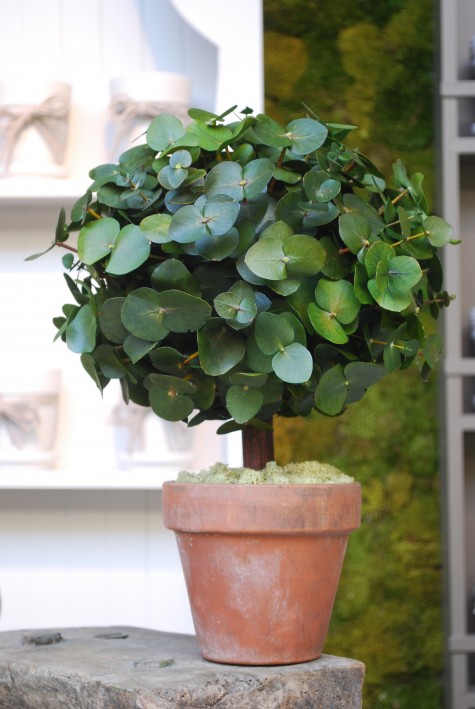 Making anything with one’s own hand is so satisfying. My friends Lauren, Buck, Marianna, Jane, Lynn, Julie and Janet-they cook. Fred’s twice a year chili extravanza-he runs a marathon for a solid two days over it; I have been a lucky recipient. Some sew, others compose. Gerhardt has not only resumed, but embraced his interrupted calling as an artist, after 30 years directing an Art Academy. At 70, he is just firing up. What and how all of them make things energizes me. Myself-I love what these small sculptures teach me about scale, proportion, texture, color, line, mass; what I put together stays with me, when I have a garden project to design.
Making anything with one’s own hand is so satisfying. My friends Lauren, Buck, Marianna, Jane, Lynn, Julie and Janet-they cook. Fred’s twice a year chili extravanza-he runs a marathon for a solid two days over it; I have been a lucky recipient. Some sew, others compose. Gerhardt has not only resumed, but embraced his interrupted calling as an artist, after 30 years directing an Art Academy. At 70, he is just firing up. What and how all of them make things energizes me. Myself-I love what these small sculptures teach me about scale, proportion, texture, color, line, mass; what I put together stays with me, when I have a garden project to design.
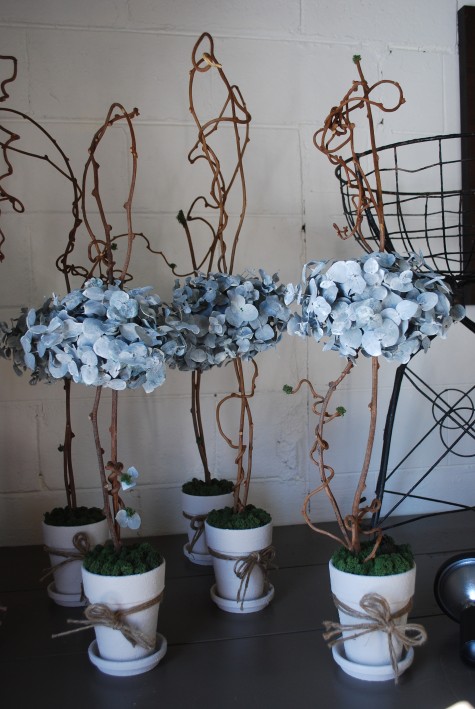 The hard wood of kiwi vine is extraordinarily beautiful. No two lengths are ever the same. Though I designed a number of these small sculptures with whitewashed eucalyptus and painted terra cotta pots, each one is different. As I compare them, I see the importance of line in a composition. I see that a signature, an arrangement of lines, is unique, and significant. Where I might apply this in my work-who knows. But I have seen this, and I will remember.
The hard wood of kiwi vine is extraordinarily beautiful. No two lengths are ever the same. Though I designed a number of these small sculptures with whitewashed eucalyptus and painted terra cotta pots, each one is different. As I compare them, I see the importance of line in a composition. I see that a signature, an arrangement of lines, is unique, and significant. Where I might apply this in my work-who knows. But I have seen this, and I will remember.

This delicate preserved foliage is the devil to work with-just ask Pam. But stuffed densely into a foam form, each individual wispy stem contributes to a mass and an overall form that engages the eye. The black dogwood stems are loosely gathered up and glued in. The lesson here- observing and working with the natural inclination of any natural material- makes for a graceful object.
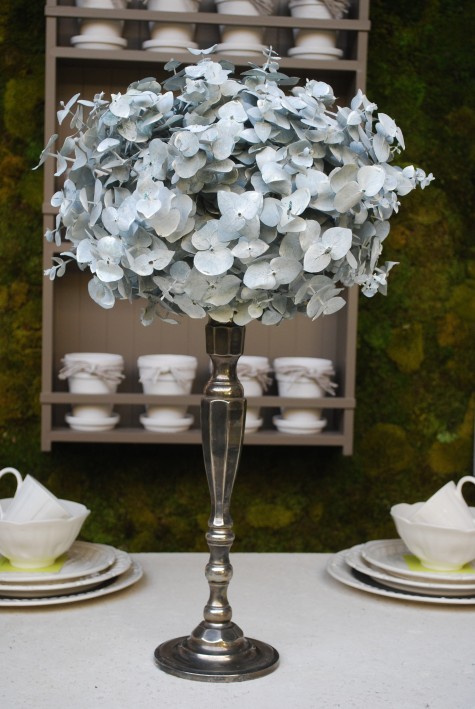 This lone silver plate candlestick I inherited-I do not remember why. For years it has been on a shelf, looking at me. The whitewashed eucalyptus unexpectedly looks good with this formal metal trunk. Every material needs the right spot to shine.
This lone silver plate candlestick I inherited-I do not remember why. For years it has been on a shelf, looking at me. The whitewashed eucalyptus unexpectedly looks good with this formal metal trunk. Every material needs the right spot to shine.
 Rob will show up from a buying trip with pots in hand-these are actually densely fabricated paper mache. A wispy and dense natural material seemed like it might make a good companion. Though my first choice would be for a topiary plant firmly rooted in the ground, in a landscape, I don’t mind this slight and skillfully made interior bound reference. Making is much about doing justice to whatever greatly interests you.
Rob will show up from a buying trip with pots in hand-these are actually densely fabricated paper mache. A wispy and dense natural material seemed like it might make a good companion. Though my first choice would be for a topiary plant firmly rooted in the ground, in a landscape, I don’t mind this slight and skillfully made interior bound reference. Making is much about doing justice to whatever greatly interests you.
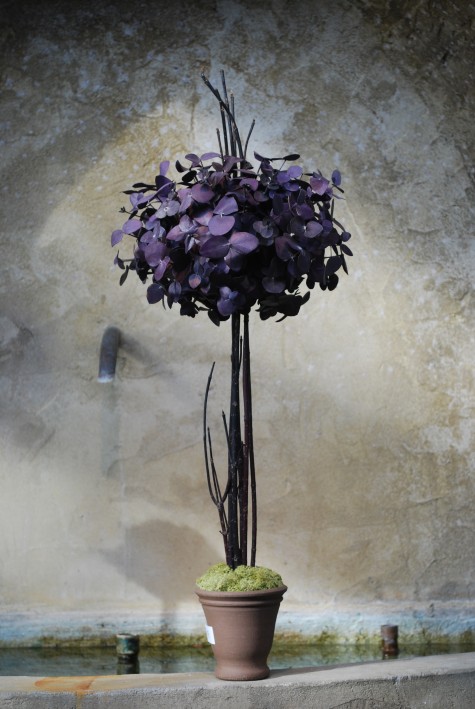
This deep purple is not a natural color in eucalyptus, but it does so celebrate the natural color of the black dogwood trunk. Have I ever seen black twig dogwood before this past fall-no! A first rate grower in Wisconsin sent me bunches of this dogwwod this past November. Regularly I see things from the natural world I have never seen before- my surprise and enchantment may fuel the winter crop of topiaries.

This winter, Pam constructed each and every one of our topiary sculptures. From my sketchy designs, she has created some very beautiful sculptures; she has a sure and an inspired hand. She is able to take an idea and confidently interpret from her own experience and eye. I am sure you can tell she is a first rate gardener, on winter leave.
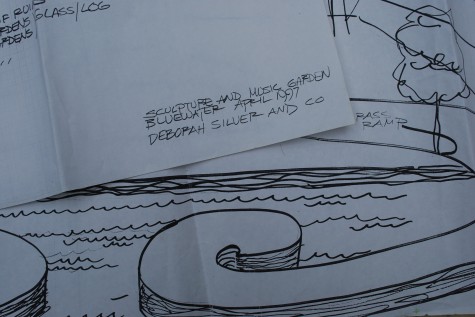 As my layout table has its first new coat of paint in 14 years, all the prints I’ve had stored there are piled up in my office. OK, I couldn’t resist taking a look before I put them back in storage. Some of them entertain me-I can see exactly what was influencing me at the time. The roll of drawings for the Bluewater project was just that-drawings. These unpolished sketches of landscape elements for a commercial project were highly conceptual-and certainly predate any computer programs that are now readily available to designers.
As my layout table has its first new coat of paint in 14 years, all the prints I’ve had stored there are piled up in my office. OK, I couldn’t resist taking a look before I put them back in storage. Some of them entertain me-I can see exactly what was influencing me at the time. The roll of drawings for the Bluewater project was just that-drawings. These unpolished sketches of landscape elements for a commercial project were highly conceptual-and certainly predate any computer programs that are now readily available to designers.  Land forms have always been of great interest to me. A big chunk of my library deals with mazes and labyrinths, land sculpture and earthworks. Robert Smithson’s 1970 sculpture “Spiral Jetty”, constructed in 6 days on a leased piece of the Great Salt Lake in Utah, is now completely landlocked as the lake is so low. The sculpture spent 20 years or better completely submerged. The sculpture has presented in many forms over the past 40 years. I have always admired it; no doubt this conceptual drawing of a maze half in and half out of some water was directly inspired by Smithson’s work.
Land forms have always been of great interest to me. A big chunk of my library deals with mazes and labyrinths, land sculpture and earthworks. Robert Smithson’s 1970 sculpture “Spiral Jetty”, constructed in 6 days on a leased piece of the Great Salt Lake in Utah, is now completely landlocked as the lake is so low. The sculpture spent 20 years or better completely submerged. The sculpture has presented in many forms over the past 40 years. I have always admired it; no doubt this conceptual drawing of a maze half in and half out of some water was directly inspired by Smithson’s work. 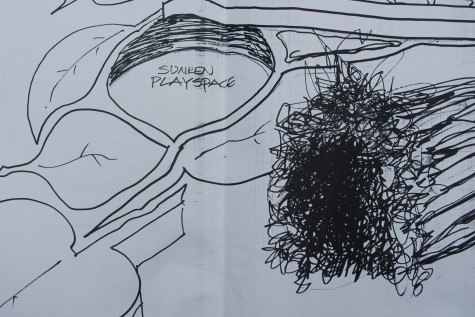 Another favorite-the land form drawings of Hans Dieter Schaal in his book “Landscape as Inspiration”. Inspired indeed. His sprawling and energetic drawings of natural forms exposed me to an entirely different way of thinking about dirt and nature. I had never seen landscape spaces rendered in this way before. I was equally taken with the beauty of the drawings. They are by no means scaled prints, they are gestural and interpretive marks on a page. This work inspired me to take up a marker and put it to a page, and see what happens. I refer to his book regularly.
Another favorite-the land form drawings of Hans Dieter Schaal in his book “Landscape as Inspiration”. Inspired indeed. His sprawling and energetic drawings of natural forms exposed me to an entirely different way of thinking about dirt and nature. I had never seen landscape spaces rendered in this way before. I was equally taken with the beauty of the drawings. They are by no means scaled prints, they are gestural and interpretive marks on a page. This work inspired me to take up a marker and put it to a page, and see what happens. I refer to his book regularly. 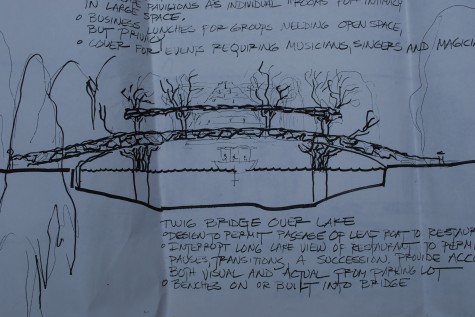 Any reference to natural forms intrigues me. A log twig bridge over Bluewater’s man-made lake seemed like just the right combination of architecture and natural materials. Buck shakes his finger at me when I design with no regard for construction, but I still think a little free spirited doodle drawing has its place. A sketch that seems to be going no where is easily discarded-provided you have not spent so much time with it that you have become attached. It is difficult to be objective about one’s own work-so I try to work fast at the conceptual stage. Anything I have invested a lot of time and work in can be hard to trash-even when trash it I should.
Any reference to natural forms intrigues me. A log twig bridge over Bluewater’s man-made lake seemed like just the right combination of architecture and natural materials. Buck shakes his finger at me when I design with no regard for construction, but I still think a little free spirited doodle drawing has its place. A sketch that seems to be going no where is easily discarded-provided you have not spent so much time with it that you have become attached. It is difficult to be objective about one’s own work-so I try to work fast at the conceptual stage. Anything I have invested a lot of time and work in can be hard to trash-even when trash it I should. 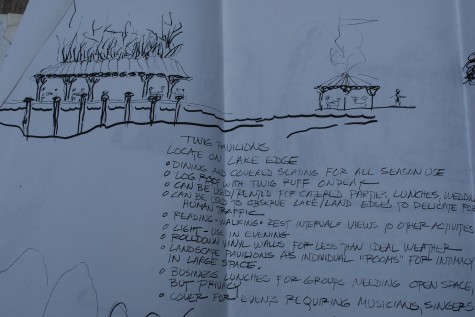 None of these drawings would convince a client to commit their time and money. But they might convince a client that there was a reservoir of ideas from which something of interest might emerge. If you don’t believe your designer is a person of interest, then a collaboration on your project is unlikely. If you are designing for yourself, drawings can bring ideas to the surface you didn’t know you had. Keeping a waste basket handy can be a comfort!
None of these drawings would convince a client to commit their time and money. But they might convince a client that there was a reservoir of ideas from which something of interest might emerge. If you don’t believe your designer is a person of interest, then a collaboration on your project is unlikely. If you are designing for yourself, drawings can bring ideas to the surface you didn’t know you had. Keeping a waste basket handy can be a comfort!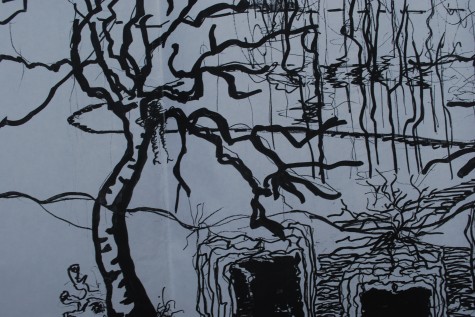 I am happy to have these drawings, not for their design, but for their energy. Being the fan of science that I am, I wholly subscribe to the notion that everything in motion tends to stay in motion-and what’s at rest tends to stay still. This applies as much to a design sensibility as it does to the physical world. Inertia being gravity that has gotten the upper hand, I make the effort to feed whatever energy I have regularly.
I am happy to have these drawings, not for their design, but for their energy. Being the fan of science that I am, I wholly subscribe to the notion that everything in motion tends to stay in motion-and what’s at rest tends to stay still. This applies as much to a design sensibility as it does to the physical world. Inertia being gravity that has gotten the upper hand, I make the effort to feed whatever energy I have regularly. 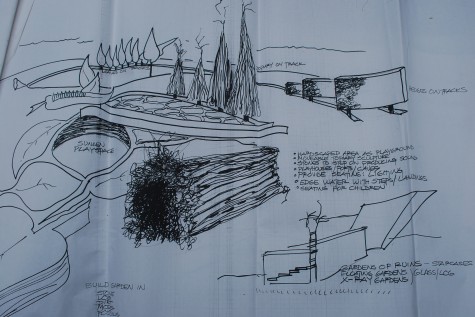 This drawing suggests at least 6 different ideas. They have similar elements, but are disconnected from each other. At the end of a series of drawings comes the integration phase. How visual and sculptural elements relate to each might be more important than any given piece. That relationship provides for good flow and rhythm. I see lots of landscapes that have good bits, but no flow. In the print, I plan for the transition between one space and another to have its own space.
This drawing suggests at least 6 different ideas. They have similar elements, but are disconnected from each other. At the end of a series of drawings comes the integration phase. How visual and sculptural elements relate to each might be more important than any given piece. That relationship provides for good flow and rhythm. I see lots of landscapes that have good bits, but no flow. In the print, I plan for the transition between one space and another to have its own space. 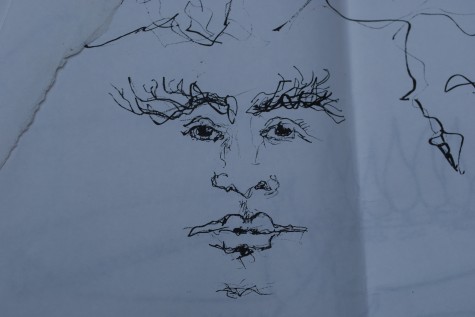
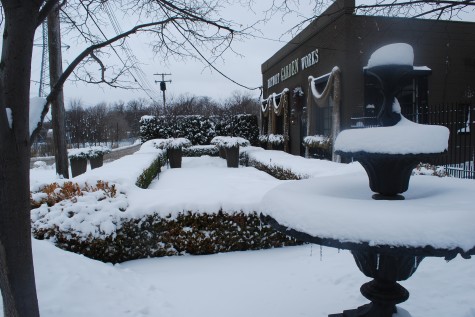 Though the shop garden is very much frozen in time, there is work under way, under ground, in anticipation of spring. We planted 2600 tulips in this garden last fall. Each and every one of those bulbs is programmed to wake up and grow, come the spring thaw. Everything needed to grow and bloom is stored and waiting inside that bulb for that moment when the switch flips. Though it seems hard to believe, tulip bulbs do not freeze solid through and through. Planted some 8″ below the surface, they spend the winter chilled to right around 32 degrees. They need that hibernation time to properly spring forth.
Though the shop garden is very much frozen in time, there is work under way, under ground, in anticipation of spring. We planted 2600 tulips in this garden last fall. Each and every one of those bulbs is programmed to wake up and grow, come the spring thaw. Everything needed to grow and bloom is stored and waiting inside that bulb for that moment when the switch flips. Though it seems hard to believe, tulip bulbs do not freeze solid through and through. Planted some 8″ below the surface, they spend the winter chilled to right around 32 degrees. They need that hibernation time to properly spring forth.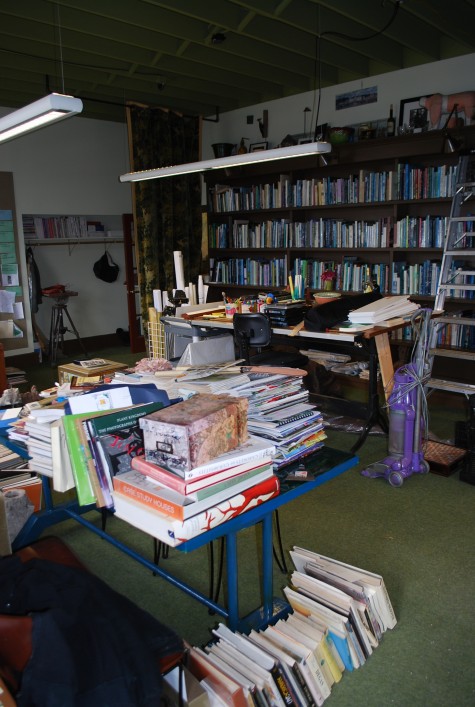 Inside the shop, it takes plenty to get ready for spring. We do a spring cleaning in February; once spring actually comes, there is no time for that. I do not mind that I have missed this part at all. Steve took every book off the library shelves, dusted them, cleaned the entire space, repainted the room, and put it all back together-all I had to do was choose the colors. Green for the walls of course-but a very light green this time. The room looks light and airy now. For the shelves and trim-what I call Belgian chocolate.
Inside the shop, it takes plenty to get ready for spring. We do a spring cleaning in February; once spring actually comes, there is no time for that. I do not mind that I have missed this part at all. Steve took every book off the library shelves, dusted them, cleaned the entire space, repainted the room, and put it all back together-all I had to do was choose the colors. Green for the walls of course-but a very light green this time. The room looks light and airy now. For the shelves and trim-what I call Belgian chocolate.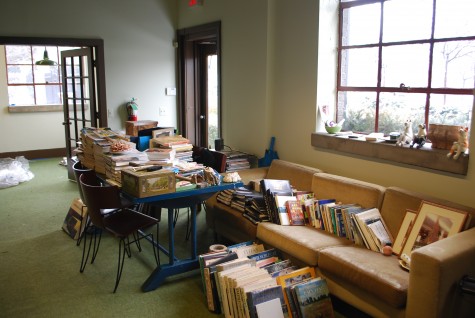 The floor of my office is courtesy of Flor-the company that makes carpet tiles in all kinds of colors and textures. This series is called house pet-it is so easy to pull up a stained square, and replace it with a new one. Gardening being the dirty business that it is, I think I am due for all new squares. Having a project indoors helps the winter fly by.
The floor of my office is courtesy of Flor-the company that makes carpet tiles in all kinds of colors and textures. This series is called house pet-it is so easy to pull up a stained square, and replace it with a new one. Gardening being the dirty business that it is, I think I am due for all new squares. Having a project indoors helps the winter fly by. 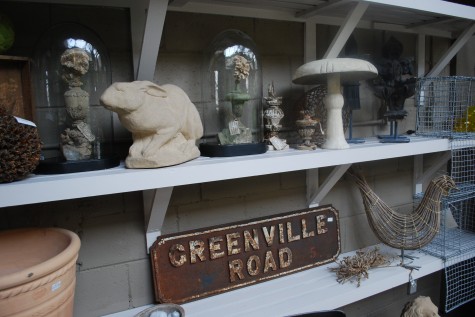
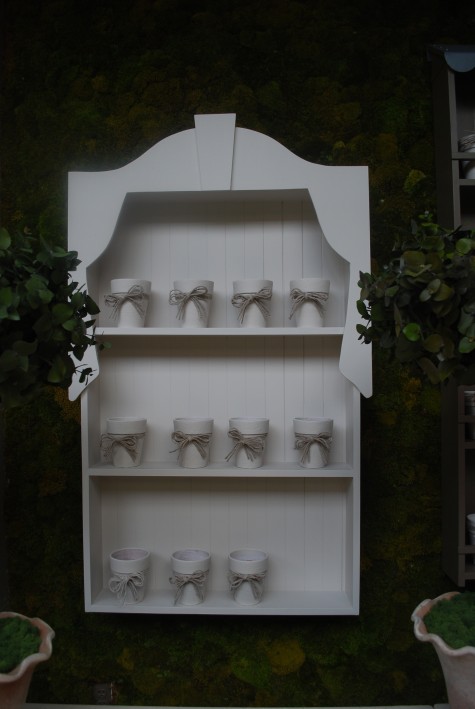 The auricula theatres got new outfits as well. The best fun was finishing the terra cotta pots. Each pot was primed in UGL basement waterproofing paint. This gave the pots a substantial gritty texture. This also keeps the top coat of paint from peeling off, once the pot is a home for wet soil. Each pot got a jute knot or bow. With the finish coat of ivory paint we soaked the bows in thinned paint; I like the look. I could see these pots planted with small growing herbs-or succulents-or even miniature ferns.
The auricula theatres got new outfits as well. The best fun was finishing the terra cotta pots. Each pot was primed in UGL basement waterproofing paint. This gave the pots a substantial gritty texture. This also keeps the top coat of paint from peeling off, once the pot is a home for wet soil. Each pot got a jute knot or bow. With the finish coat of ivory paint we soaked the bows in thinned paint; I like the look. I could see these pots planted with small growing herbs-or succulents-or even miniature ferns. 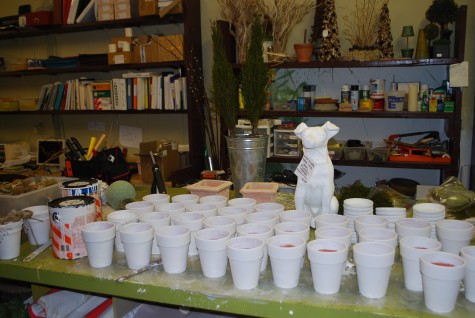 They layout table was handy for painting the pots. I could never again do without a table at a height comfortable for me to stand and work. This we made with a 4 by 8 foot sheet of exterior grade plywood. The top is held up by a pair of shelves four feet deep. These shelves hold long blueprints that I need to store.
They layout table was handy for painting the pots. I could never again do without a table at a height comfortable for me to stand and work. This we made with a 4 by 8 foot sheet of exterior grade plywood. The top is held up by a pair of shelves four feet deep. These shelves hold long blueprints that I need to store. The little pots look great. Machine made terra cotta pots can be finished in so many ways, when you tire of that orange clay. This shape is called a rose pot-they are taller than standard terra cotta pots. They are great for growing plants with long root runs. Bareroot roses that are potted up for sale at nurseries are generally on the tall side. Large rose pots are also great for growing tomatoes. Rose pot and long tom are interchangeable common names for pots taller than they are wide.
The little pots look great. Machine made terra cotta pots can be finished in so many ways, when you tire of that orange clay. This shape is called a rose pot-they are taller than standard terra cotta pots. They are great for growing plants with long root runs. Bareroot roses that are potted up for sale at nurseries are generally on the tall side. Large rose pots are also great for growing tomatoes. Rose pot and long tom are interchangeable common names for pots taller than they are wide. 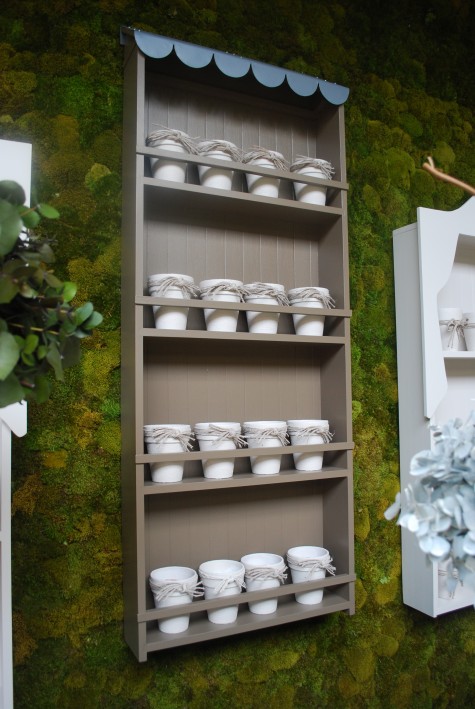 One of the plant theatres got a coat of Belgian chocolate paint.
One of the plant theatres got a coat of Belgian chocolate paint. 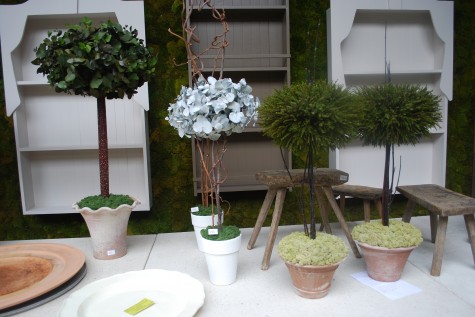 Pam has been making small topiary sculptures from preserved eucalyptus and other preserved greens. The trunks are made from cedar whips, kiwi vine, and fresh blacktwig dogwood. They are great for spots indoors asking for something soft, that will not support plant life. As I have no interest in house plants, these suit me fine.
Pam has been making small topiary sculptures from preserved eucalyptus and other preserved greens. The trunks are made from cedar whips, kiwi vine, and fresh blacktwig dogwood. They are great for spots indoors asking for something soft, that will not support plant life. As I have no interest in house plants, these suit me fine. 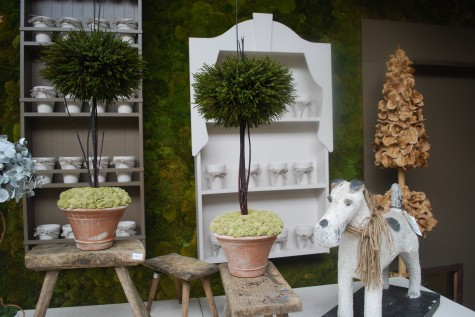
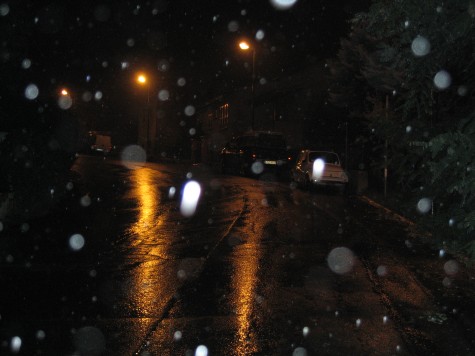 Black can be described by the absence of color, and the absence of light. Black objects absorb every spectrum of light, diametrically opposed to the reflective action of white. Black and white-simple, spare, and elegant. Black and light? Though our summer light lasts long into the evening, the night landscape is well worth some thought. A dark and rainy landscape can be visually challenging, and beautifully moody.
Black can be described by the absence of color, and the absence of light. Black objects absorb every spectrum of light, diametrically opposed to the reflective action of white. Black and white-simple, spare, and elegant. Black and light? Though our summer light lasts long into the evening, the night landscape is well worth some thought. A dark and rainy landscape can be visually challenging, and beautifully moody. 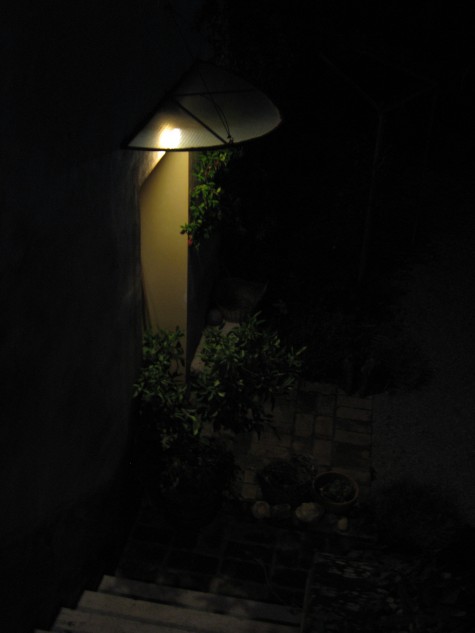 Black Baccara roses, Queen of the Night Tulips, and chocolate cosmos are not really black-they are dark versions of red or purple. Salix melanostachys, or black pussy willow, has branches that approach black. But true black in the landscape is about shadow-light and dark. The relationship of light and shadow in the landscape is a visual story that gets play every day, regardless of the season, or the time of day.
Black Baccara roses, Queen of the Night Tulips, and chocolate cosmos are not really black-they are dark versions of red or purple. Salix melanostachys, or black pussy willow, has branches that approach black. But true black in the landscape is about shadow-light and dark. The relationship of light and shadow in the landscape is a visual story that gets play every day, regardless of the season, or the time of day. 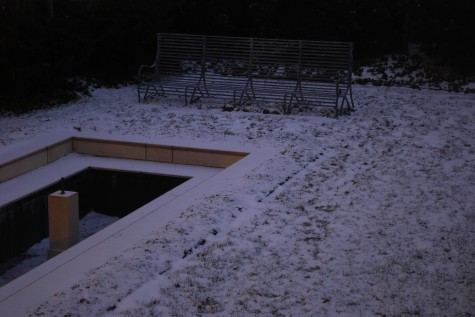
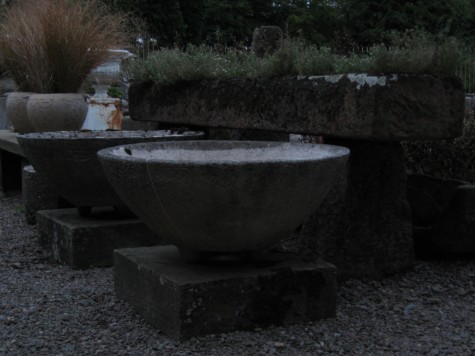 Low light reduces contrast, but none the less the white painted urn in this picture reads white, and the shadows cast by the stone cistern read black. Where am I going with this? Depending on the degree of shade, certain spots in a garden may also be described as voids. Contrasting something with nothing-this is part of composing. Like the silence after a thunderclap, black in a garden is a place for your eye to rest, and regroup.
Low light reduces contrast, but none the less the white painted urn in this picture reads white, and the shadows cast by the stone cistern read black. Where am I going with this? Depending on the degree of shade, certain spots in a garden may also be described as voids. Contrasting something with nothing-this is part of composing. Like the silence after a thunderclap, black in a garden is a place for your eye to rest, and regroup. 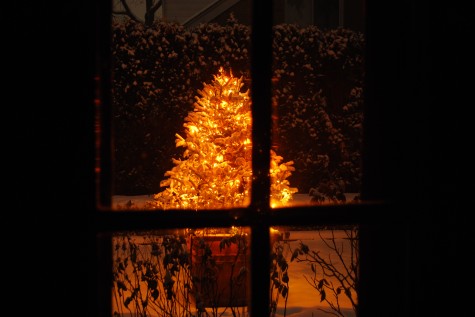 The only reason I am able to see anything of my side garden on a winter night is courtesy of the lights on this tree. Landscape lighting is easy to dislike. Rarely do I see it done in a subtle way; lots of times I see theatrical versions that might be fun on first glance, but tiresome over time. I like my theatre on stage, or my glitz and glam at a hotel where my visit is entertainingly brief. Thus I like strings of lights in the garden-lots in some places and a little in others-even after the holidays.
The only reason I am able to see anything of my side garden on a winter night is courtesy of the lights on this tree. Landscape lighting is easy to dislike. Rarely do I see it done in a subtle way; lots of times I see theatrical versions that might be fun on first glance, but tiresome over time. I like my theatre on stage, or my glitz and glam at a hotel where my visit is entertainingly brief. Thus I like strings of lights in the garden-lots in some places and a little in others-even after the holidays. 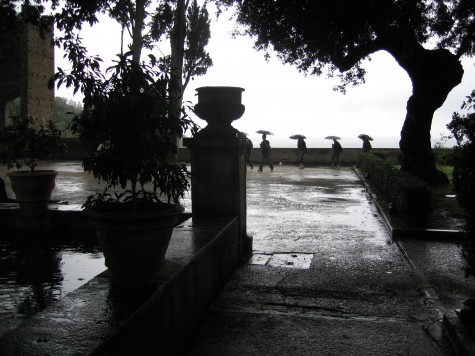 Any part of a landscape that is strongly backlit will throw the unlit side of every shape black. Both natural and man made forms in silhouette are striking. Composing and layering a space effectively can read in a very powerful way on a dark day. Though it sounds odd to say so, the sky is an important part of any landscape composition.
Any part of a landscape that is strongly backlit will throw the unlit side of every shape black. Both natural and man made forms in silhouette are striking. Composing and layering a space effectively can read in a very powerful way on a dark day. Though it sounds odd to say so, the sky is an important part of any landscape composition. 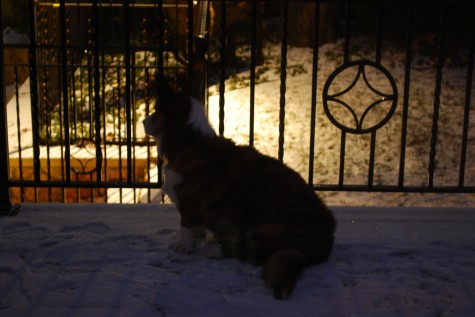
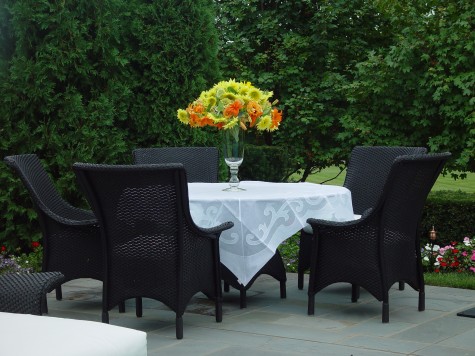 This black garden furniture is formally elegant. The lower shapes of the chairs read well against the light grey blue of the stone terrace. The tops of the chairs appear much more subtle against their dark green background. The interior leaves and needles of the trees actually appear much more black than the chairs to my eye. The texture of the embroidered white tablecloth is highlighted by the black table underneath.
This black garden furniture is formally elegant. The lower shapes of the chairs read well against the light grey blue of the stone terrace. The tops of the chairs appear much more subtle against their dark green background. The interior leaves and needles of the trees actually appear much more black than the chairs to my eye. The texture of the embroidered white tablecloth is highlighted by the black table underneath. 